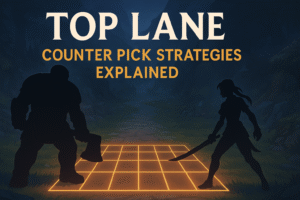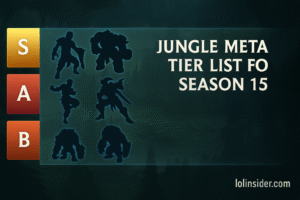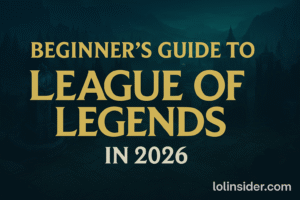League of Legends is constantly evolving. Each patch brings small tweaks, but every so often, the game undergoes a meta shift that fundamentally changes how matches are played. One of the most impactful transformations in recent years has been the shift from early game dominance to late game scaling focus.
Gone are the days when a level 2 gank or a tower dive could decide the game by the 10-minute mark. Instead, more games are being decided by late-game teamfights, scaling champions, and objective setups around Baron and Elder Dragon.
This article explores how and why this meta shift occurred, its impact on pro play and solo queue, and what strategies you need to adapt to thrive in the new environment.
Chapter 1: The Early Game Meta Era
In past seasons, League of Legends was often decided within the first 15 minutes. Early dragons, turret plates, and snowball mechanics rewarded aggressive teams.
- Jungle Impact: Junglers like Lee Sin, Elise, and Rek’Sai dominated with early pressure.
- Mid Lane Priority: Champions like Twisted Fate and Syndra created map-wide threats early.
- Tower Plates: Introduced in Season 9, they gave laners strong gold advantages.
The philosophy was simple: Get a lead early, snowball objectives, and close the game before scaling champions became relevant.
Chapter 2: The Rise of Late Game Scaling
Recent patches, item changes, and systemic updates have shifted the balance. Scaling champions now shine brighter than ever before.
- Itemization Changes: Mythics and late-game item buffs reward carries like Jinx, Kai’Sa, Kassadin, and Kayle.
- Objective Value: Elder Dragon and Baron became win conditions rather than bonuses.
- Game Length Increase: Matches trend longer due to durability updates and reduced early snowball.
Now, the meta favors teams that weather the early storm and execute around 25–35 minutes with scaling carries.
Chapter 3: Champions Defining the Late Game
ADCs
- Jinx, Aphelios, Kai’Sa – Shred through late-game teamfights.
Mid Lane
- Kassadin, Azir, Viktor – Weak early, unstoppable late.
Top Lane
- Ornn, Kayle, Gwen – Utility or scaling powerhouses.
Jungle
- Karthus, Master Yi, Sejuani – Scale or provide peel for late-game carries.
Chapter 4: Pro Play Impact
Professional teams have embraced the late-game focus, shifting their drafts and strategies.
- Drafting Scaling: Teams prioritize hyper-carries and supportive enablers.
- Objective Setup: Vision control around Baron and Elder Dragon is everything.
- Reduced Early Aggression: Lane swaps and turret dives are less common.
Examples:
- Worlds 2021–2023 Finals showcased scaling comps deciding championships.
- LCK and LPL prioritize late-game stability rather than coin-flip early aggression.
Chapter 5: Solo Queue Meta
In solo queue, adapting to this shift can be the difference between climbing and tilting.
- Play Safe Early: Don’t force fights unless you have clear jungler support.
- Prioritize Scaling Picks: Champions like Kassadin or Jinx can carry games at 30 minutes.
- Objective Awareness: Even in solo queue, late-game dragons decide matches.
Pro Tip: Don’t give up if you fall behind early. The scaling meta gives comeback opportunities if you stall.
Chapter 6: Strategic Adjustments for Players
- Supports: Peel and vision matter more—champions like Lulu and Thresh thrive.
- Junglers: Focus on farming and tracking enemy jungler over risky early ganks.
- ADCs: Play safe, scale, and position well in late-game fights.
- Top Laners: Prioritize teamfight impact over lane dominance.
Chapter 7: The Future of the Meta
League of Legends is always shifting. Will Riot revert to an early-game emphasis, or will scaling remain dominant? Much depends on:
- Item adjustments (buffs/nerfs to early lethality vs late crit).
- Objective tuning (dragon buffs, Rift Herald power).
- Durability changes in patches.
History shows that the pendulum swings back and forth. Staying adaptable is the ultimate skill.
FAQs on Meta Shift
Q1: Why did the meta shift to late game?
Systemic changes like durability updates and objective rewards favored scaling.
Q2: Is early game no longer important?
It still matters, but it’s less game-ending. Early leads now translate into better setups for scaling, not immediate victories.
Q3: Which roles benefit most from the late-game meta?
ADCs and mid laners gain the most, while supports and junglers adapt to enable them.
Q4: Can early-game champs still work?
Yes, but they require precise execution. A failed early snowball often means falling behind scaling comps.
Conclusion
The meta shift from early game to late game focus has redefined how League of Legends is played. Players must adapt to longer games, scaling champions, and the importance of late objectives.
In both pro play and solo queue, success now hinges on discipline: play safe early, control vision mid, and execute perfectly in late-game fights.
If you master these adaptations, you’ll thrive in the evolving Rift—no matter where the meta swings next.







